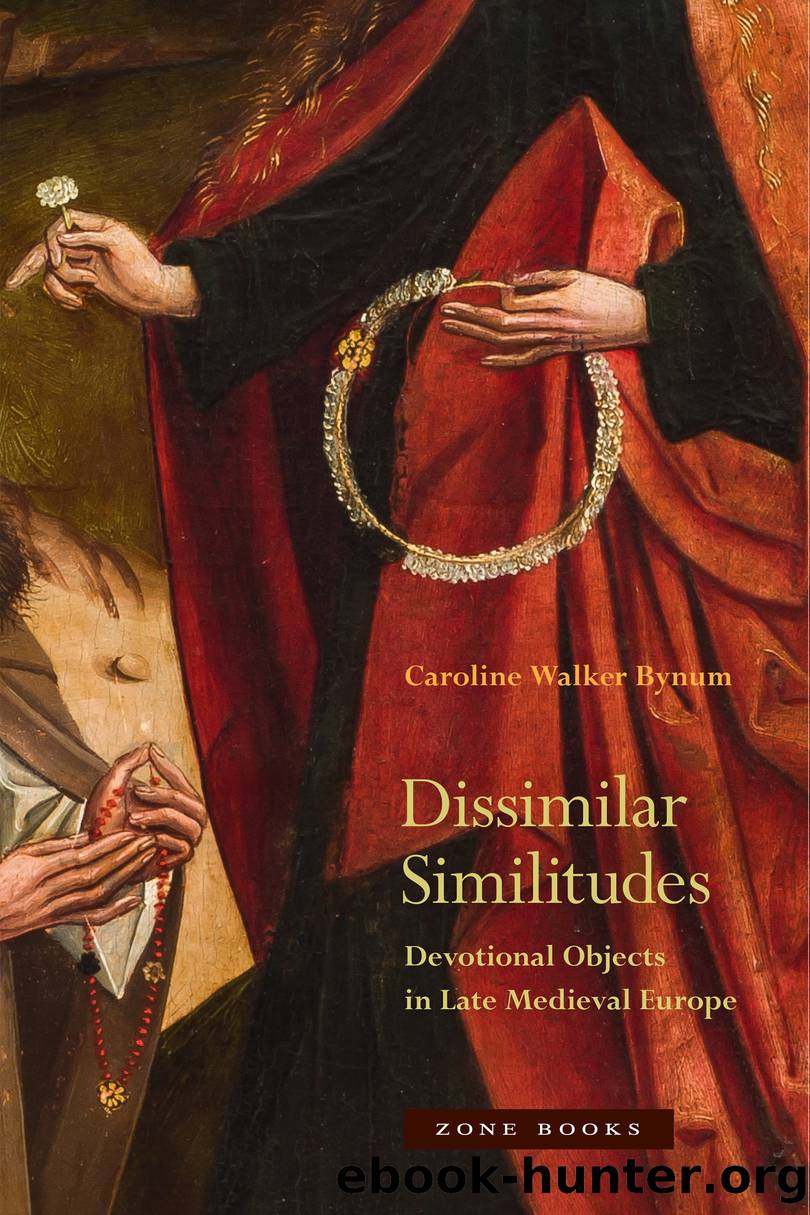Dissimilar Similitudes by Bynum Caroline Walker;

Author:Bynum, Caroline Walker;
Language: eng
Format: epub
Publisher: Zone Books
Published: 2020-07-17T00:00:00+00:00
Calling the ceremony a âconsecration rite,â Freedberg remarks: âIt is significant that many [such] rites involve the last stages of completing an image and bringing it to life.â60 Scholars have recently struggled with a variety of concepts, such as âdistributive agencyâ and ârepresentation,â61 to express what is happening in these ceremonies, but whatever refinement of terminology they use, they stress that the power of an Other is here emerging in the material object we call an image.
For Freedberg and for many other scholars, the eye-opening ritual in Buddhism, Hinduism, and ancient China has provided a paradigm.62 In fact, the Indian example makes it clear that the process is lengthier and more labile than a focus on providing eyes suggests. Indian images come to life in a series of rites or processes, from the initial selection of appropriate material for carving (wood from a male tree for a male god, for example) to awakening by the chiseling or painting in of eyes. Although the image is âmadeâ by those who carve and anoint it, the god is latently present, lying, as NammÄḻvÄr put it, like âbutter ⦠in fresh milk.â The image is then bathed, dressed, and adorned with unguents, and the devotee both recognizes and is recognized, locking eyes with the god (darshan).63 Presence depends on the lengthy process of handling the god and on the expectation, which itself must be prepared, of the devotee.
Recent discussions of the parallels between Western and non-Western images have helpfully complicated earlier descriptions of the art of the European Middle Ages. As I have discussed elsewhere, standard textbook accounts of the iconoclastic controversy in the early Middle Ages have been misleading in their tendency to focus on theology more than practice.64 Nor do traditional accounts adequately describe the awe-ful potency of the images that were increasingly feared and rejected in the fifteenth and sixteenth centuries.65 Thus, it has been crucial for historians to jettison formulations that see Western images as simply triggers of devotion, inducements to something beyond or other than the images.66 Non-Western cases have helped European medievalists rediscover the power of images themselves.
Nonetheless, much of the recent study of Christianity seems to me to adduce the wrong Western/non-Western comparisons. Not only is it misleading to compare Durga and Mary as if their processions were parallel, it seems misleading to assume that we will probe the nature of sacred presence most deeply if we compare statues. As I explained earlier, much recent work is predicated on the assumption that comparanda are, and should be, morphologicalâthat is, visually similar. Indeed, in all this work, scholars have tended to treat the really interesting parallel as that of anthropomorphic image to anthropomorphic image; the starting point is thus âlook-alikes,â especially human âlook-alikes.â Implicated in this is the use, especially by art historians, of the term âimageâ (imago) to designate what has come in the West to be considered âart,â although historically the term refers to figures of speech and ontological relationships as well.67 Yet surely what
Download
This site does not store any files on its server. We only index and link to content provided by other sites. Please contact the content providers to delete copyright contents if any and email us, we'll remove relevant links or contents immediately.
Resisting Happiness by Matthew Kelly(2902)
The Social Psychology of Inequality by Unknown(2338)
Designing Your Life by Bill Burnett(2294)
Day by Elie Wiesel(2259)
The Giving Tree by Shel Silverstein(1859)
Angels of God: The Bible, the Church and the Heavenly Hosts by Mike Aquilina(1639)
Human Design by Chetan Parkyn(1588)
Augustine: Conversions to Confessions by Robin Lane Fox(1479)
The Supreme Gift by Paulo Coelho(1457)
Hostage to the Devil by Malachi Martin(1406)
7 Secrets of Divine Mercy by Vinny Flynn(1401)
Jesus of Nazareth by Joseph Ratzinger(1396)
Dark Mysteries of the Vatican by H. Paul Jeffers(1357)
The Vatican Pimpernel by Brian Fleming(1347)
St. Thomas Aquinas by G. K. Chesterton(1324)
Saints & Angels by Doreen Virtue(1316)
My Daily Catholic Bible, NABRE by Thigpen Edited by Dr. Paul(1214)
Called to Life by Jacques Philippe(1209)
The Ratline by Philippe Sands(1175)
